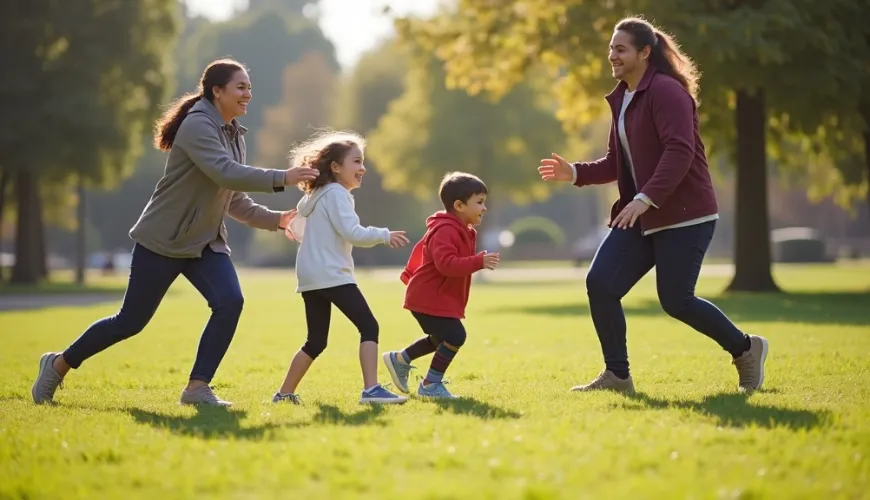
Fun Warm-Up Activities You'll Love During Exercise

Why Warming Up is Key to Better Sports Performance (Not Just in School)
Warming up. Two words we've heard since childhood during physical education classes, at gyms, or before a race. But why do so many coaches, teachers, and physiotherapists emphasize it so much? And can it make sense outside the sports field? A proper warm-up isn't just an introductory ritual before physical activity; it's often a crucial factor that determines whether we truly enjoy the exercise—or end up with a pulled muscle or back pain.
Warming up the body before sports is like waking up from a deep sleep. The body slowly awakens, organs activate, muscles get more blood flow, and the mind begins to focus on the upcoming activity. Without this phase, the body is caught off guard, inflexible, and more prone to injury. But have you ever thought that there are many types of "warm-up activities" suitable not only for the gym? And that warming up doesn't always have to be just boring arm circles?
What Happens in the Body During a Warm-Up?
When we start with light movement, such as jogging in place or dynamic stretching, the body increases its temperature. Muscles become more flexible, the heart starts pumping more blood, and therefore oxygen, to all parts of the body. The nervous system is better prepared for quick reactions and coordination. A warm-up is not just about physical preparation; it's also about mental tuning—it helps us get into a state of focus and readiness.
According to a study published in the Journal of Strength and Conditioning Research, a proper warm-up can increase performance by up to 7%. It might not sound like much, but in the context of professional sports, those few percentages can decide victory.
Different Types of Warm-Up Activities - From Classics to Creativity
Warm-ups are not one-size-fits-all. They vary depending on the activity, environment, age, and current condition of the exerciser. However, there are activities that have proven effective across various settings—from school gyms to training camps for sports teams.
1. Dynamic Warm-Up
Unlike static stretching, which was common in the past, emphasis is now placed on dynamic warming up. This means stretching the body in motion—for example, lunges with torso rotations, jumping jacks, or high-knee runs. These movements not only increase body temperature but also activate specific muscle groups needed for the sport.
2. Coordination and Game Activities
Especially for children and adolescents, it's important that the warm-up is fun. Game-based warm-ups, such as tag, "mirror movements" (where one leads and the other mimics), or team mini-challenges, are not only entertaining—they also develop alertness, team spirit, and coordination.
For example, at an elementary school in Brno, a physical education teacher replaced the classic lap around the field with a ball game, where kids had to run, jump, throw, and collaborate. "The kids were not only more enthusiastic but also physically better prepared for the main part of the lesson," she says.
3. Mental Warm-Up
Especially for athletes preparing for important competitions, mental warm-ups are increasingly used. Visualization of performance, breathing exercises, or short meditation help calm nerves and increase concentration. Such techniques are also effective in everyday life—say, before an important presentation at work. So why not indulge in a "mental warm-up" outside of sports?
Why Should Even Non-Athletes Warm Up?
You might think, "This is nice, but I don't exercise, why should I warm up?" However, warming up isn't just about preparing for a run or match. It's a habit of healthy movement that anyone can adopt—as a morning ritual, an active break during work, or a stretch before an evening walk.
In this era of sedentary lifestyles and computer work, it's not uncommon to experience back pain, neck strain, or wrist issues. Regular warm-up activities—like a series of three-minute exercises when getting up from the desk—can prevent these problems. Simple shoulder rolls, light back stretches, or a few squats can make the body feel different right away.
What Should an Effective Warm-Up Look Like?
Everyone has their preferences, but it's worth sticking to a few basic rules. Before you go all out, start with a short warm-up—such as jogging in place or a few jumps. Then add brisk movements targeting the muscles you'll be using. Don't forget to practice a bit of balance and coordination. The entire warm-up should take at least 5 to 10 minutes, nothing complicated, but your body will thank you.
For children and seniors, it should be primarily playful and safe. It's not about performance but preparing the body for healthy movement.
Warm-Up as Part of an Active Lifestyle
In recent years, there's been more emphasis on the idea that a healthy lifestyle is not just about what we eat but also how we move. And warm-up activities are becoming a key piece of this puzzle. They help not only physically but also mentally—by teaching us to listen to our bodies, develop mindful movement, and appreciate the moment.
In community centers, schools, and companies, "active breaks" are starting to appear—short sequences of movement serving as a warm-up during the day. They help improve concentration, boost mood, and reduce physical stiffness. Many companies abroad routinely include short warm-up blocks in their work schedules. And the first pioneers are appearing in the Czech Republic.
Inspiration for Everyday Life
You can start your morning with a short warm-up—not as a record-breaking workout, but more as a pleasant ritual to get you moving and started. Just two minutes of circling your shoulders, head, and wrists, followed by a minute of light squats, another minute of lunges with arms overhead, and finally two minutes of calm breathing with a forward bend. It's not rocket science, just a smooth start to a new day.
In six minutes, you'll gain more energy than from a second cup of coffee.
Also, before a walk, bike ride, or gardening, a short warm-up can significantly reduce the risk of injury. And if you take your kids to the playground, try running together or doing a "jumping challenge"—not only will you teach them something about health, but you'll also strengthen your relationship.
A warm-up isn't just the gateway to sports performance. It's a tool to feel better in your body, care for it, and not neglect it. In a time when technology tempts us into inactivity, the warm-up is one of the simplest ways to return to natural movement. Whether you're exercising, working, or caring for children—don't forget to "warm up" occasionally. Because just as we need a little time to wake up each morning, our bodies need those minutes to function at their best.

